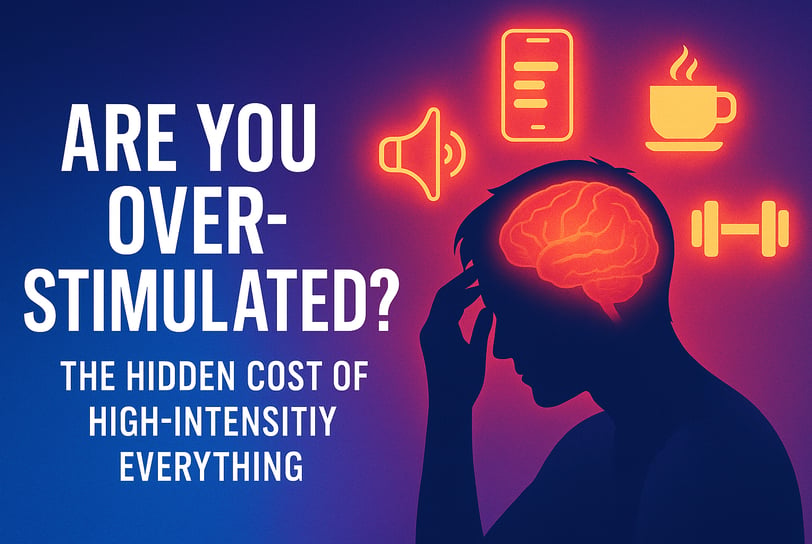Are You Overstimulated? The Hidden Cost of High-Intensity Everything
High-performance habits may be draining your nervous system. Explore the real cost of overstimulation—on your brain, body, and recovery—and learn how to reset with science-backed strategies.
Ignacio Fernandez
6/24/20253 min read


Are You Overstimulated? The Hidden Cost of High-Intensity Everything
We live in a culture that worships more: more reps, more caffeine, more notifications, more 24-hour hustle. At first, the rush feels empowering—until creeping irritability, brain fog, and phantom aches start to whisper that something’s off. Welcome to the era of chronic overstimulation, where the body’s stress circuits never get a chance to dim the lights.
Below is the deep dive you didn’t know you needed—how nonstop intensity hijacks hormones, rewires your brain, and even flattens your mood-reward system. (And yes, we’ll map out science-backed ways to hit the brakes without sacrificing drive.)
1. The Neural Cost of “Always-On”
From a biological standpoint, intensity is meant to be brief. High arousal states flood your limbic system with adrenaline, sharpen reaction time, and then subside. But when high stakes become a baseline—think relentless HIIT classes, triple espressos, doom-scrolling news—your brain’s salience network stays revved. Synapses shift into “threat scanning” mode and plasticity tilts toward anxiety conditioning rather than learning.
2. Cortisol: From Ally to Saboteur
Acute spikes in the stress hormone cortisol keep you alert and help mobilize fuel. Chronic spikes, though, impair hippocampal neurons responsible for memory and emotional balance. A practical buffer is moderating morning stimulants: replacing that second coffee with an adaptogenic brew such as Four Sigmatic Adaptogen Blend can blunt runaway cortisol without killing productivity.
3. Sensory Bombardment & Your Brain’s Bandwidth
Your reticular activating system filters incoming data so you’re not overwhelmed. Overexposure to flashing screens, loud gyms, and pavement-pounding playlists exhausts that filter—leading to headaches, jumpiness, and poor executive function. Sensory scientists call this allostatic overload: the cost of maintaining stability through constant change.
4. CNS Fatigue vs. Mental Burnout — Same Fire, Different Fuel
Athletes know central-nervous-system fatigue torpedoes power output. Knowledge workers feel the cognitive twin: decreased creativity, slower decision-making. Tracking heart-rate variability (HRV) is a simple reality check; a dip often precedes both forms of burnout. A strap like the Polar H10 Heart Rate Monitor pairs with most HRV apps and gives hard data on whether you’re thriving—or just surviving.
5. Digital Dopamine & the Shrinking Attention Span
Instant pings trick the midbrain into rapid dopamine squalls, training you to crave constant novelty. Over time, reward receptors down-regulate, so you need louder stimuli to feel the same spark. That’s why a quiet room suddenly feels uncomfortable—it’s withdrawal. Re-sensitizing those pathways requires scheduled dopamine fasts: blocks of zero screens or stimulants.
6. Autonomic Tug-of-War: Sympathetic vs. Parasympathetic
In a balanced system, the vagus nerve counters fight-or-flight surges with rest-and-digest calm. Chronic overstimulation weakens this brake line, cranking baseline heart rate and blood pressure. Daily five-minute vagal drills—like humming combined with long exhalations—can rebuild tone. For tactile feedback, the Apollo Neuro-Nerve Toning Pebble delivers low-frequency vibration that cues deeper parasympathetic activation.
7. Sleep Debt—The Silent Multiplier
Intensity junkies often treat sleep as negotiable, but inadequate deep-wave cycles impair glymphatic “brain washing,” amplifying neural waste and inflammation. One study shows even a single all-nighter spikes amyloid-β accumulation linked to Alzheimer’s risk. Protecting sleep means ditching blue light and stabilizing temperature; the ChiliSleep Cube Sleep System circulates cooled water under your sheets, nudging core temperature into the sweet spot for delta-wave recovery.
8. Gut-Brain Fallout: When Stress Meets Microbiome
High-octane living boosts gut permeability (“leaky gut”), letting inflammatory molecules like LPS slip into circulation. That inflammation feeds back to the brain, worsening anxiety and depression—a vicious loop. A polyphenol-rich probiotic such as Just Thrive Probiotic & Antioxidant has shown promise in reducing endotoxin load and restoring gut-brain harmony.
9. Micro-Dosing Downtime: The 2-Minute Reset
You don’t need a sabbatical—just strategic micro-pauses. Two minutes of diaphragmatic breathing, eyes closed, every two hours drops catecholamines measurably. Movement snacks—like five cat-cows or a doorway pec stretch—flush accumulated muscle tension and recalibrate proprioception.
10. Building Rituals of Recovery (That Actually Stick)
Humans crave rhythm; recovery works best when it’s as automatic as brushing your teeth. Stack habits onto triggers: foam-rolling quads while the coffee brews, or journaling right after powering down the laptop. A versatile tool such as the TriggerPoint GRID Foam Roller makes quick tissue resets painless—so you’re more likely to keep the ritual alive.
Final Take: The Power of the Pause
High-intensity experiences are thrilling and, in bursts, powerful growth stimuli. The danger lies in turning peaks into a permanent plateau. Chronic overstimulation taxes every regulatory circuit—hormonal, neural, digestive—until what once felt energizing leaves you drained. The antidote isn’t quitting ambition; it’s respecting oscillation: stress ↔ recovery, noise ↔ silence, action ↔ stillness. Master that rhythm, and intensity becomes a springboard again—rather than a slow-motion crash.
Sources & Expert Insights
Allostatic Overload (2024 systematic review)
Summarises how chronic high-arousal states drive multi-system strain → fatigue, CV risk
Stress-Induced Hippocampal Shrinkage
Reviews neuronal loss & memory decline from prolonged cortisol exposure
Digital Overuse & Dopamine Pathways (2023 neuro review)
Details reward-circuit down-regulation from excessive social-media stimulation
HRV as Burnout Biomarker (2025 study)
Finds low HRV predicts clinical burnout, validating CNS-fatigue section
FITNESS
Nutrition
WellnesS
info@movebetterco.com
© 2025. All rights reserved | Privacy Policy | Terms & Conditions